You are hereBlogs
Blogs
Holiday Bridge in the region
Xmas parties are behind us as we settle in to the Holiday Season.
The AGM at Matamata will be held on Thursday 7.30 on the 14th December which includes prize giving for the year.
If you are still keen on bridge then fear not ... there are still options available - Wednesday daytime bridge continues in Matamata but starts at a new time of 1pm for the next few weeks and will restart in the New Year.
Te Aroha will continue with social bridge on Tuesday nights at 7.15pm and Friday's from 11.30am unti December 22nd and will resume in the New Year - All welcome... but keep an eye on the website for developments as it will be based on customer demand!
New Year's party?? We will let you know details on this closer to the date also.
We have pencilled in Richard Solomon to do a 'night out' in Te Aroha on Friday 2ndd February pitched to Intermediate players and will be open to Te Aroha, Matamata and Morrinsville players.
I Hope everybody is winding down and looking forward to celebrating the festive season with friends and family.
Looking forward to 2018!
Te Aroha Christmas Party
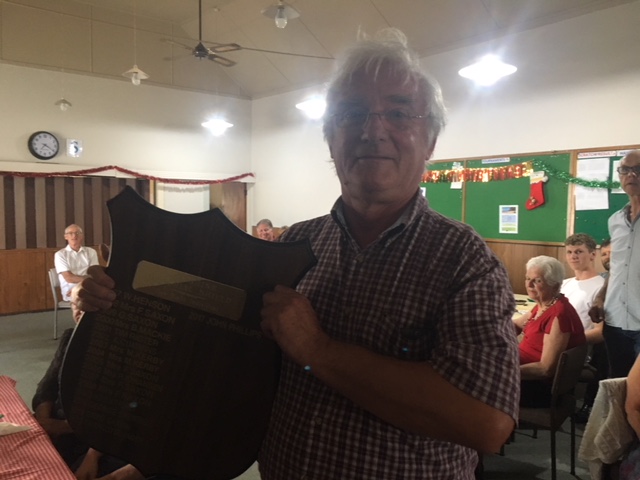
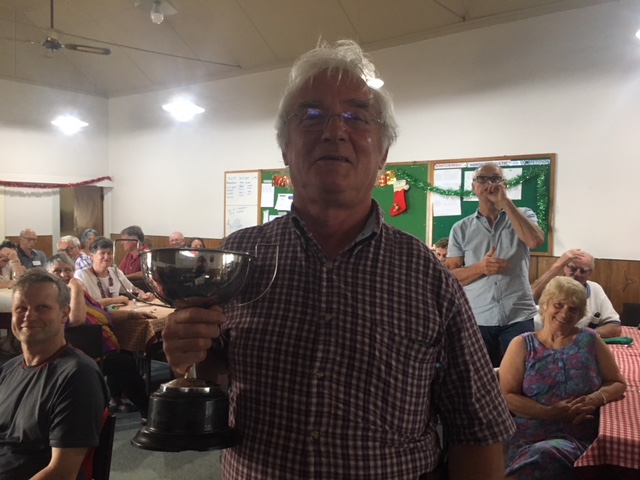

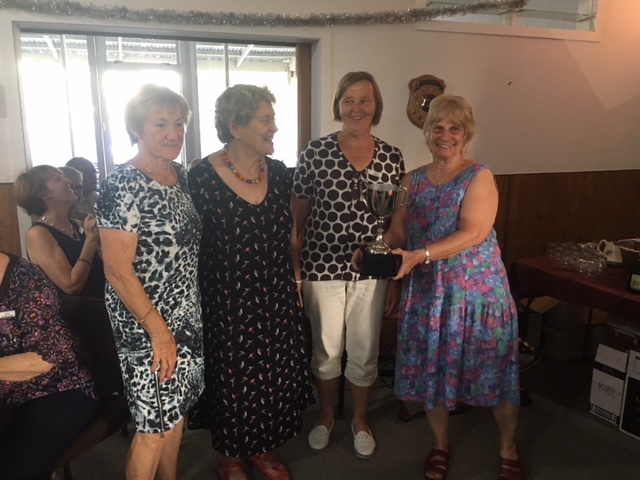
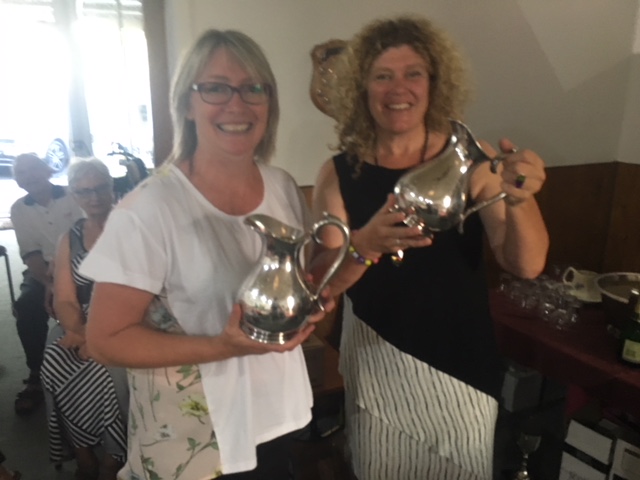
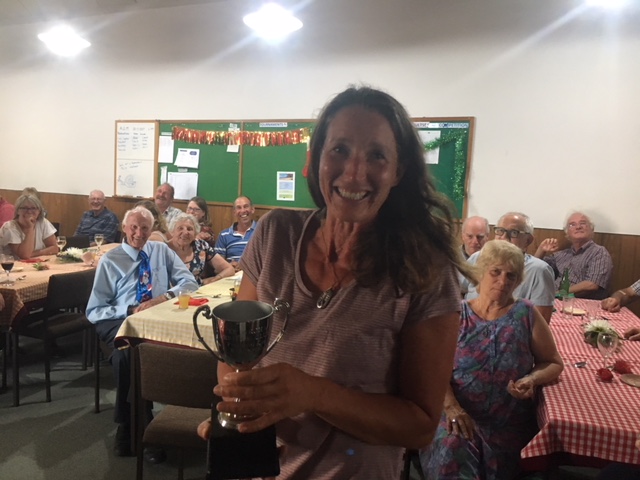

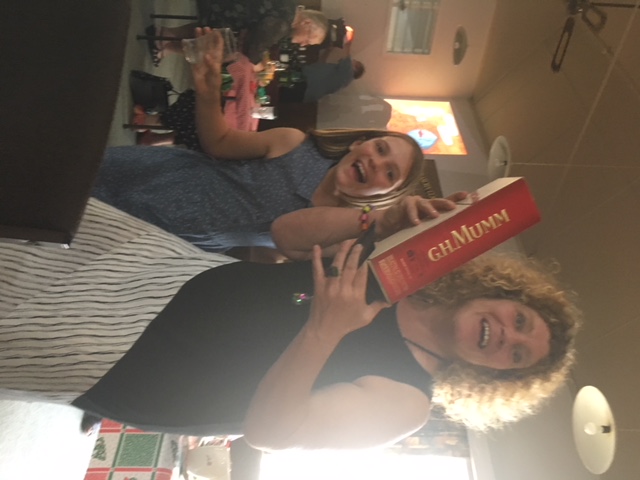
AGM and Christmas Parties at Matamata
The season wraps up next week with a few events:
Theme: GOLD. All the glitters isn't gold (wear something sparkly)
Wednesday 6th December bridge Xmas Party
- Plate for shared lunch
- $5.00 gift (optional)
Thursday 7th December evening bridge
- small plate for supper (suggest one person cooks, one pays)
- prizes for scratch and handicap
The AGM and prizegiving also takes place at 7.30pm on 14th December.
Attached is a notice for the events and further details on the AGM.
Kathy and Ken win the National Teams
Congratulations to Kathy and Ken Yule who along with Ian Berrington and Fuxia Wen won the 15A National Teams in Tauranga over the weekend.
Richard Solmon from NZ Bridge has written a great summary of their success on the NZ Bridge website which is available here: http://www.nzbridge.co.nz/latest-updates,listing,3983,yuletide-comes-ear...
The format was 8 x 14 board matches over the weekend and they went into the last match with a comfortable lead ... perhaps they took it bit easier in the last round (but probably not! as they registered a loss on the last round they had done the hard yards to take the victory by 5VPs.

Another local success was Noel Grigg who was part of the third place team who teamed up with heavy weights Steve Boughey, Andi Boughey and Carol Richardson.
There was also a Xmas tournament at Te Awamutu over the weekend and Lynette Morgan and Ian Bond were 3rd with Lesley Quilty and Sonia in 6th.
Well done everybody!
Friday afternoon Bridge grows in Te Aroha
Okay it could have been because it was raining, but it was nice to see 6 tables being used on Friday afternoon bridge this week.
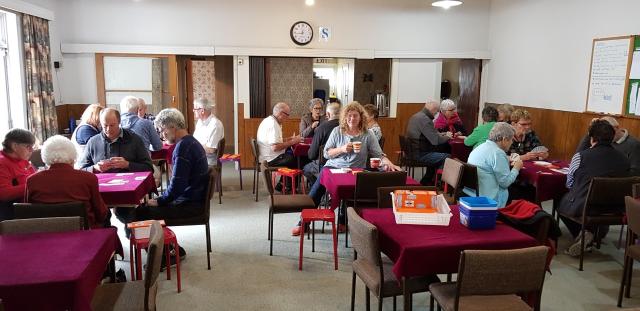 Clubrooms
Clubrooms
Friday bridge only kicked off this year and it has had consistent support from a number of clubs including Matamata, Morrinsville and Thames. We also welcomed some old Te Aroha members back who no longer played night bridge.
You don't need to have a partner to play at Te Aroha on Fridays AND you don't have to become an associate member. We guarantee a game if you arrive by 11.25 (11.30am start). To cater for our farmers and parents we will try and get finished by 2.15pm. Lunch is grabbed during a break in the play or if we have a phantom although for some they have an early lunch.
All welcome we would love to see you!
Well done Charlotte and Victor (and other Piako club members!)
Charlotte Jager and Victor Kooter won the last Junior Tournament of the Waikato Bay league today with two 65%+ sessions in Te Awamutu today.

The win took Charlotte to the top of the league ladder with 38 points with Victor second with 31 (if only he hadn't missed an event due to a trip to the Netherlands!). Also on the winners circle was Malcolm Kirkby who came 4th equal.
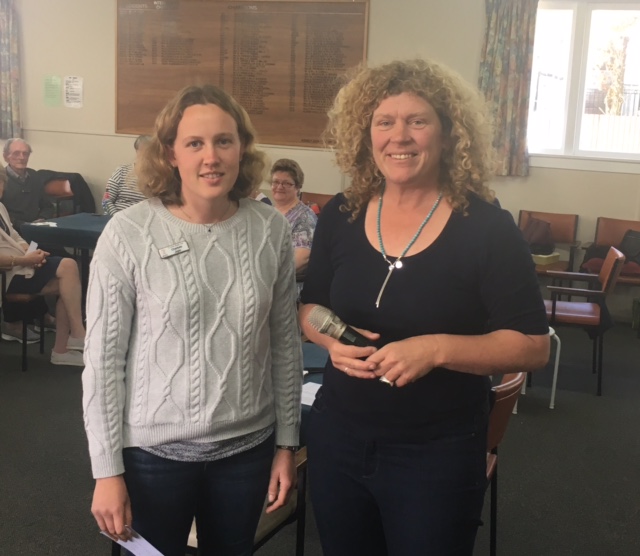 Charlotte and Anna
Charlotte and Anna
Charlotte receiving her prize from Waikato Bays rep Anna Kalma ... who also had a good weekend coming 2nd at the Te Puke open tournament with Tom Henwood as her partner. Henk and Hermanna Hemmes also won a session prize at Te Puke in the morning and Noel Grigg and Jena Robinson were first in the afternoon.
NZ Congress week
You might have noticed things being a bit quieter at the bridge clubs last week ... NZ's premier event - the NZ Bridge Congress took place in Hamilton running from Friday through to the following Saturday - 9 days of bridge up for grabs. Not everybody took part in every event but there was also some great results from our locals;
The event started with the Youth Teams and Jacob Kalma and Adrian Wisse competed in the Waikato team who were in top place after the round robin but lost in the final to the Johnstone team who featured many top Australian players.
Then onto the NZ Pairs and Open Restricted Pairs. Kathy and Ken Yule were the only qualifiers from our area into the next round and eventually got 6th in the plate finals. Jacob and Anna Kalma had a poor start in the Open Restricted Pairs but pulled back over the following 3 rounds and ended in 6th place.
For those that didn't qualify into the finals of the Pairs, the option was to play in the Back to the Future Teams event - an event where you play a round with every person in your team. Lynette Morgan, Ian Bond, Lesley Quilty and Anna Kalma managed to make it into the final 13 teams and finished 11th.
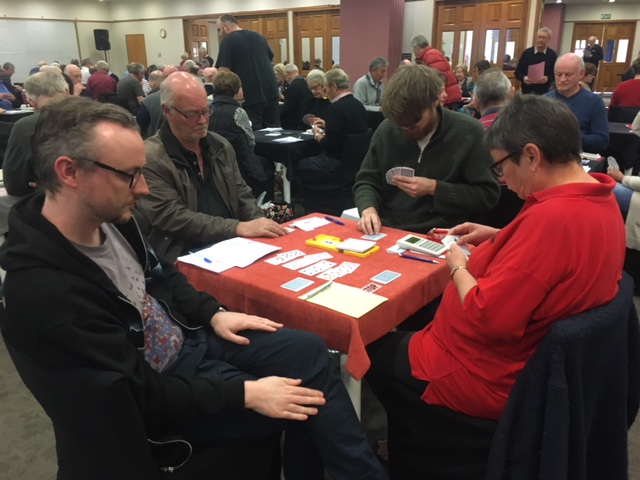
The NZ Teams is the premier event at Congress with 110 teams competing. Ken and Kathy Yule competed in the Jarvis Team who qualified 6th making the top 16 teams and then played through to the quarter final being knocked out after an appeal from their opponents (the eventual runners up) overturned the result.
The field then gets to choose to play in a variety of events ... Intermediate Pairs, Mixed Pairs, Senior Pairs or Same-Sex pairs. Best result was for Lesley Quilty and Tom Henwood who came third in the Senior Pairs ... Tim Rigter and Rochelle van Heuven came 10th in the Intermediate section while Anna Kalma & Tom Winiata came 9th in the Mixed Pairs.

Onto the next competition; Senior Teams, Point-A-Board or Intermediate Teams. Great result from our senior citizens - Lesley Quilty, Sonia Crawford, Tom Henwood & Tom Winiata who won the senior teams.
While in the meantime Tim Rigter, Rochelle van Heuven, Charlotte Jager and Anne Leighton were 3rd in the Intermediate Teams - another great result in a strong field.
Finally the ultimate events of the tournament; Swiss Pairs with opportunities to play in the Intermediate, Restricted or Open.
Jacob Kalma and his Auckland partner Jeremy Fraser-Hoskin did well to come 4th in the Restricted Swiss and Tim Rigter and Rochelle van Heuven backed up their previous form by coming 4th in the Intermediate Swiss... also a great result from juniors Peter Daffurn and June Zhu who punched above their weight to come 20th in the Intermediate.
In the open - Sonia Crawford and Anna Kalma were also having a great run and were coming 12th with just a couple of sessions to go ... but sadly their stamina let them down (or perhaps it was the lunchtime wine!) and they slipped to 44th ... meantime Lynette and Ian ended their congress with a very credible 31st in the large and strong field.
It was great to see many other Matamata, Te Aroha and Morrinsville club members taking part in the event ... Rochelle who was at her first Congress and came away with 10A points ... commented that she was amazed by how enjoyable it was ... it wasn't intimidating at all and most people were friendly (there is always one or two old trouts at the table!) and says that we should be promoting it a lot wider next year.

Recent winners and events at Te Aroha
well done to the Te Aroha BIGGEST TWIT team that took home the inaugural junior TWIT trophy and spoils.

Other recent club champ winners include the 4 leaf clover team that came from behind in the Saxon teams to snatch victory and proving that luck had nothing to do with it!
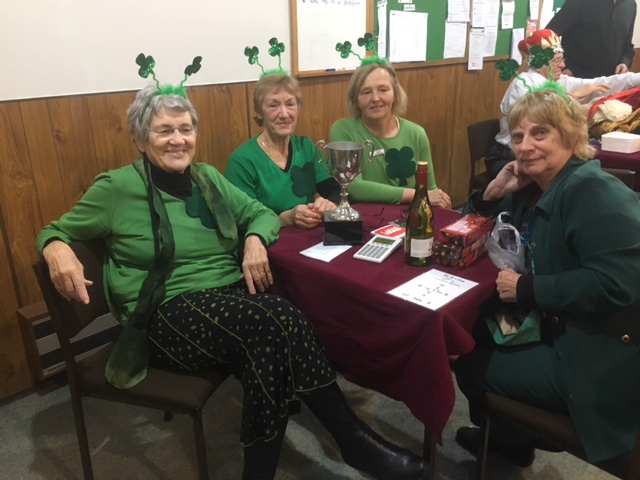
NZ Bridge Congress - starts Friday 29th September
NZ Bridge Congress takes place starting this end of this week at the Distinction Hotel in Te Rapa {next to the Waterworld}
Congress isn't just for the seasoned players - there are events for Novice, Junior and Intermediate as well as a Restricted Open alongside the major open sessions.
We encourage any Novice players {ie those who learnt bridge in 2015, 2016 or 2017} OR those with less than 5 B {or rating} points to come along and play in a special afternoon session on Saturday afternoon starting at 2pm and experience the buzz of NZ's premier event which costs just $10.
You can either rock up on the day with your partner ... or if you would like help arranging a partner talk to your tutor or club captain.
All the information regarding the event including entries and programme are available via the NZ Bridge website: http://www.nzbridge.co.nz/congress.html
Good luck to all the Matamata-Piako members who will be travelling to the event.
Intermediate Tournament in Matamata
We had a quality field turn up in Matamata on Sunday from as far North as Auckland and South to New Plymouth.
Winners with a great afternoon session and a pretty decent morning one as well were Waikato pair John Little and Graham Saunders
.JPG)
Second place went to Rochelle van Heuven and Tim Rigter of Te Aroha.

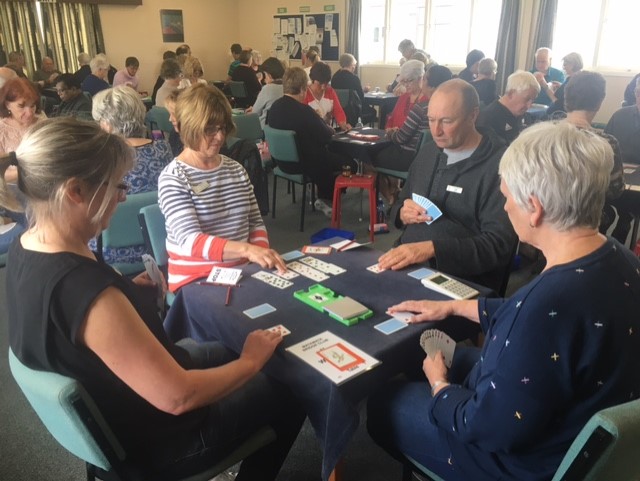 Intermediate: The top pairs from the Morning session square off against each other at the start of session 2. Te Aroha's Rochelle van Heuven and Tim Rigter vs Cambridge's Vicky Jacobsen and Jenny Oxley.
Intermediate: The top pairs from the Morning session square off against each other at the start of session 2. Te Aroha's Rochelle van Heuven and Tim Rigter vs Cambridge's Vicky Jacobsen and Jenny Oxley.
The hand of the day came courtesy of Board 11 in session 2...
Dealer south none vulnerable.
| ||||||||||
|
| |||||||||
|
With shape and favourable vulnerability for both sides, many in the field were pushed into slam. While 6 by South shouldn't make according to the makeables - this would only have been with a spade lead - but this would have been an unusual lead from West who was sitting there with a shed load of diamonds and singleton A of Clubs.
by South shouldn't make according to the makeables - this would only have been with a spade lead - but this would have been an unusual lead from West who was sitting there with a shed load of diamonds and singleton A of Clubs.
Most south's would open a preemptive 3 or even 4 . We suspect that nobody looked for the E-W spade fit with West eventually overcalling 5
. We suspect that nobody looked for the E-W spade fit with West eventually overcalling 5 . North with 15 points and looking an 11 card fit in hearts easily calls 5
. North with 15 points and looking an 11 card fit in hearts easily calls 5 . West, understandably has fallen in love with their hand and calls onto slam much to the dismay of East with their 2 mere points. The lucky ones get doubled by North and make their contract. The unlucky ones get outgunned by North bidding 6
. West, understandably has fallen in love with their hand and calls onto slam much to the dismay of East with their 2 mere points. The lucky ones get doubled by North and make their contract. The unlucky ones get outgunned by North bidding 6 and the really unlucky ones then go and double North-South who then make their slam!
and the really unlucky ones then go and double North-South who then make their slam!
 AJ
AJ KQJ65
KQJ65